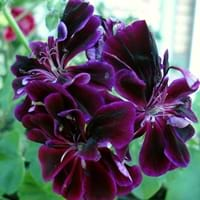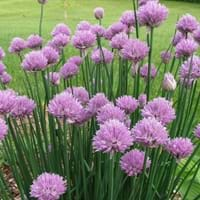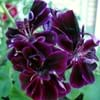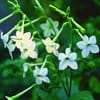Life Span
Annual
Perennial
Type
Tender Perennial
Herbs
Origin
Hybrid origin
World/Pandemic, North America, Europe, Asia
Types
Not Available
Common chives, Garlic chives, Siberian garlic chives, Giant Siberian chives
Habitat
All sorts of environments
Rocky areas
USDA Hardiness Zone
10-15
4-9
AHS Heat Zone
Not Available
9-1
Sunset Zone
8, 9, 12, 13, 14, 15, 16, 17, 18, 19, 20, 21, 22, 23, 24
A1, A2, A3, H1, H2, 1a, 1b, 2a, 2b, 3a, 3b, 4, 5, 6, 7, 8, 9, 10, 11, 12, 13, 14, 15, 16, 17, 18, 19, 20, 21, 22, 23, 24
Habit
Clump-Forming
Clump-Forming
Flower Color
Hot Pink, Coral
White, Pink, Lavender
Flower Color Modifier
Bicolor
Not Available
Fruit Color
Not Available
Black
Leaf Color in Spring
Green
Green, Light Green
Leaf Color in Summer
Green
Green
Leaf Color in Fall
Green
Green, Yellow green
Leaf Color in Winter
Light Green
Not Available
Leaf Shape
Acicular
Grass like
Plant Season
Spring, Summer, Fall, Winter
Spring, Summer, Fall
Sunlight
Full Sun, Partial Sun
Full Sun, Partial Sun
Type of Soil
Loam, Sand
Loam, Sand
The pH of Soil
Neutral
Neutral
Soil Drainage
Well drained
Well drained
Bloom Time
Indeterminate
Late Spring, Early Summer
Tolerances
Drought
Not Available
Where to Plant?
Ground, Pot
Ground, Pot
How to Plant?
Leaf Cutting, Root Division, Seedlings, Stem Cutting
Seedlings, Transplanting
Plant Maintenance
Medium
Medium
Watering Requirements
Do not water excessively
Requires regular watering, Water every two or three days during warmer months, Water when soil is dry
In Summer
Moderate
Lots of watering
In Spring
Moderate
Moderate
In Winter
Average Water
Average Water
Soil Type
Loam, Sand
Loam, Sand
Soil Drainage Capacity
Well drained
Well drained
Sun Exposure
Full Sun, Partial Sun
Full Sun, Partial Sun
Pruning
Prune regularly, Remove damaged leaves, Remove dead branches, Remove dead leaves
Prune in spring, Prune in summer, Prune to stimulate growth, Remove deadheads
Fertilizers
All-Purpose Liquid Fertilizer, fertilize every 2-3 weeks while growing
All-Purpose Liquid Fertilizer
Pests and Diseases
Red blotch, Whiteflies
Bacterial leaf spot, Damping-off, Downy mildew, head rot, Pink Root, Rust, Thripes
Plant Tolerance
Heat And Humidity
Drought
Flower Petal Number
Semi-Double
Single
Fragrant Bark/Stem
Yes
Yes
Foliage Texture
Medium
Fine
Foliage Sheen
Matte
Matte
Attracts
Not Available
Not Available
Allergy
Not Available
Asthma, Diarrhea, Itchiness, Pain and fatigue, Skin rash
Aesthetic Uses
Showy Purposes
Not Used For Aesthetic Purpose
Beauty Benefits
Moisturizing, Skin cleanser
Not Available
Environmental Uses
Air purification, Insect Repellent
Air purification
Medicinal Uses
Fever, Intestinal irritations, Kidney problems, Respiratory Disorders, Wounds
Antioxidants, Bone strength, Improve heart health, Nutrients
Part of Plant Used
Flowers
Leaves, Seeds
Other Uses
Cosmetics, Culinary use, Making Perfumes, Oil is used for aromatherapy, Showy Purposes, Used as a nutritious food item
Employed in herbal medicine, Used As Food
Used As Indoor Plant
Yes
Yes
Used As Outdoor Plant
Yes
Yes
Garden Design
Bedding Plant, Container, Edging, Hanging Basket, Houseplant, Mixed Border
Alpine, Cutflower, Edible, Herb / Vegetable, Mixed Border, Rock Garden / Wall
Botanical Name
PELARGONIUM 'Balgalpipn'
ALLIUM schoenoprasum
Common Name
Hybrid Ivy-leaved Geranium, Zonal Geranium
Chives, Cultivated Chives, Garden Chives
In Hindi
Pelargonium
Chives
In German
Pelargonium
Schnittlauch
In French
Pelargonium
Ciboulette
In Spanish
Pelargonium
Cebollino
In Greek
Pelargonium
βολβοί φαγώσιμοι
In Portuguese
pelargônio
Cebolinha
In Polish
Pelargonium
Szczypiorek
In Latin
Pelargonium
Sectivi porri
Phylum
Magnoliophyta
Spermatophyta
Class
Magnoliopsida
Liliopsida
Order
Geraniales
Asparagales
Family
Geraniaceae
Liliaceae
Clade
Angiosperms, Eudicots, Rosids
Angiosperms, Monocots
Tribe
Not Available
Not Available
Subfamily
Not Available
Allioideae
Number of Species
Not Available
Season and Care of Pelargonium and Chives
Season and care of Pelargonium and Chives is important to know. While considering everything about Pelargonium and Chives Care, growing season is an essential factor. Pelargonium season is Spring, Summer, Fall and Winter and Chives season is Spring, Summer, Fall and Winter. The type of soil for Pelargonium is Loam, Sand and for Chives is Loam, Sand while the PH of soil for Pelargonium is Neutral and for Chives is Neutral.
Pelargonium and Chives Physical Information
Pelargonium and Chives physical information is very important for comparison. Pelargonium height is 25.40 cm and width 30.50 cm whereas Chives height is 203.00 cm and width 15.20 cm. The color specification of Pelargonium and Chives are as follows:
Pelargonium flower color: Hot Pink and Coral
Pelargonium leaf color: Green
Chives flower color: White, Pink and Lavender
- Chives leaf color: Green and Light Green
Care of Pelargonium and Chives
Care of Pelargonium and Chives include pruning, fertilizers, watering etc. Pelargonium pruning is done Prune regularly, Remove damaged leaves, Remove dead branches and Remove dead leaves and Chives pruning is done Prune in spring, Prune in summer, Prune to stimulate growth and Remove deadheads. In summer Pelargonium needs Moderate and in winter, it needs Average Water. Whereas, in summer Chives needs Lots of watering and in winter, it needs Average Water.





